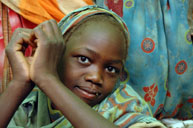
REUTERS/Claire Soares

Refugee girls miss out on learning, play - UN
LONDON (AlertNet) - Many refugee girls and young women miss out on education for practical reasons such as a lack of separate toilets, but making simple improvements to camp schools can encourage more to attend, the U.N. deputy high commissioner for refugees said on Tuesday.
To mark World Refugee Day, the U.N. refugee agency (UNHCR) has launched a global online campaign entitled ninemillion.org, which aims to increase awareness of the plight of the world's 9 million refugee and displaced children.
It will also raise money from individuals and the private sector, with an initial target of $9 million. Two-thirds will be distributed by UNHCR to support education in refugee communities, with a focus on helping girls attend school.
"All too often in refugee camps, girls are a minority in schools ... So we're trying to find ways to reduce the obstacles that keep girls from getting into the classroom," UNHCR Deputy High Commissioner Wendy Chamberlin told AlertNet in an interview.
"It's a bit of a myth that the obstacles to girls' education are cultural or religious. It's often as much a simple thing that can be easily removed, like privacy in toilets. If there are latrines in schools, girls will come. And it's a bit delicate, but girls can't go to school if they don't have sanitary napkins."
Other barriers include a lack of school uniforms and female teachers.
In Africa, the U.N. refugee body estimates that around a quarter of the refugee population is made up of girls under the age of 18. Most of those children do not have access to formal education. In 2002, girls made up 39 percent of pupils at UNHCR-assisted primary schools and only 29 percent at secondary school.
According to UNHCR, girls and young women in conflict and post-conflict situations are less likely than boys and men to access basic rights. Their education is often overlooked in favour of male children, and parents often depend on girls to work at home.
THERAPY ON THE PLAYING FIELD
Most refugee girls are also denied the chance to participate in sport, which can help them overcome psychological trauma and support their development, Chamberlin said.
One third of the money raised by the ninemillion.org campaign will fund sport and play programmes for refugee youth, run by international sports charity Right to Play, with an emphasis on getting girls and young women out on the playing field.
Chamberlin cited the case of a teenage girl in Uganda who had been raped many times, but was able to start dealing with her experiences after joining a volleyball initiative set up by Right to Play.
"It was very important to her to be involved in physical exercise in a team, and she didn't think about what had happened to her so much anymore," Chamberlin said.
In Dadaab, Kenya, Somali women and girl refugees are now able to participate in sport thanks to a joint initiative between UNHCR and Nike to design culturally sensitive sports clothing. For many Muslim women, tight shirts and shorts are out, but the special uniforms allow them to "protect their modesty and cultural traditions", Chamberlin said.
Sports-based projects provide girls and young women with opportunities to participate more actively in public life and can offer a starting point for boosting the status of women, according to the refugee agency.